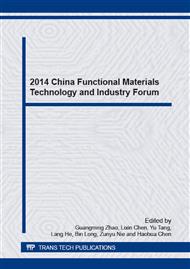p.207
p.213
p.218
p.222
p.231
p.237
p.243
p.248
p.252
Fabrication of Highly Ordered Two-Dimensional Graphene Arrays on Patterned Substrate
Abstract:
We report a facial and straightforward method to fabricate highly ordered two-dimensional graphene arrays. A monolayer molecule pattern with alternative hydrophilic/hydrophobic wetting property was first formed by using micro-contact printing (μCP) and self-assembly techniques. Water droplets were condensed on the hydrophilic areas under saturated water atmosphere, which could be used to construct the ordered graphene arrays. The optical microscopy and atom force microscopy results indicate that ring and porous arrays of graphene can be obtained with low and high concentration of graphene solutions, respectively. Without the water droplet template, graphene patterns with square structure were produced.
Info:
Periodical:
Pages:
231-236
Citation:
Online since:
December 2014
Authors:
Keywords:
Price:
Сopyright:
© 2015 Trans Tech Publications Ltd. All Rights Reserved
Share:
Citation:



